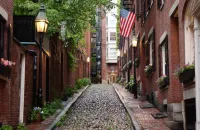Weather forecasting employs scientific and technological methods to predict atmospheric conditions for specific locations and times. Informal weather prediction has existed for millennia, while formal forecasting began in the 19th century. It leverages scientific understanding and technological tools to anticipate future weather patterns, aiding in various aspects of human life, from daily planning to disaster preparedness.
1911: First Marine Weather Forecasts via Radio
In 1911, the Met Office began issuing the first marine weather forecasts via radio transmission, including gale and storm warnings for areas around Great Britain. This marked a significant advancement in disseminating weather information to maritime communities.
1922: Publication of "Weather Prediction By Numerical Process"
In 1922, Lewis Fry Richardson, an English scientist, published "Weather Prediction By Numerical Process", detailing a method for numerical weather prediction using finite differencing schemes based on fluid dynamics equations. This publication marked a foundational step towards modern numerical weather forecasting.
1925: First Public Radio Forecasts in the US
In 1925, Edward B. "E.B." Rideout of the U.S. Weather Bureau made the first public radio weather forecasts in the United States on WEEI, the Edison Electric Illuminating station in Boston. This was a crucial step in bringing weather information directly to the public.
1931: WBZ Weather Forecasts
In 1931, G. Harold Noyes, also from the U.S. Weather Bureau, started providing weather forecasts on WBZ radio, further expanding the reach of weather information to the public.
November 1936: First Televised Weather Forecasts by the BBC
In November 1936, the BBC experimentally broadcast the world's first televised weather forecasts, including the use of weather maps. This was a pioneering effort in visual weather communication.
1940: Experimental Television Forecasts in Cincinnati
In either 1940 or 1947, James C. Fidler made experimental television forecasts in Cincinnati on the DuMont Television Network, contributing to the early development of televised weather reporting.
1947: Experimental Television Forecasts in Cincinnati
In either 1940 or 1947, James C. Fidler made experimental television forecasts in Cincinnati on the DuMont Television Network, contributing to the early development of televised weather reporting.
1954: First Televised Weather Forecast with On-Screen Map
In 1954, George Cowling presented the first televised weather forecast while standing in front of a weather map, marking a significant advancement in how weather information was presented on television.
1955: Practical use of numerical weather prediction
In 1955, the practical application of numerical weather prediction began, spurred by the development of programmable electronic computers. A team including Jule Charney, Philip Duncan Thompson, Larry Gates, Ragnar Fjørtoft, John von Neumann, and Klara Dan von Neumann performed the first computerized weather forecast.
1963: Edward Lorenz's Proposal on Long Range Forecasts
In 1963, Edward Lorenz proposed that long-range weather forecasts (two weeks or more) cannot definitively predict the state of the atmosphere due to the chaotic nature of fluid dynamics equations. He noted that small errors in initial values double roughly every five days for variables like temperature and wind velocity in numerical models.
1982: Launch of The Weather Channel (TWC)
In 1982, John Coleman partnered with Frank Batten to launch The Weather Channel (TWC), a 24-hour cable network dedicated to national and local weather reports. Coleman also pioneered the use of on-screen weather satellite data and computer graphics for television forecasts in the late 1970s and early 1980s.
2009: US Spending on Weather Forecasting
In 2009, the United States invested approximately $5.8 billion in weather forecasting, which yielded benefits estimated to be six times that amount. This highlights the economic importance of weather forecasting.
2022: Emergence of AI Weather Models
In 2022, initial attempts to use artificial intelligence in weather forecasting led to the emergence of models like Huawei's Pangu-Weather, Google's GraphCast, WindBorne's WeatherMesh, Nvidia's FourCastNet, and the European Centre for Medium-Range Weather Forecasts' AIFS.
2023: Continued Development of AI Weather Models
In 2023, AI weather models like Huawei's Pangu-Weather, Google's GraphCast, WindBorne's WeatherMesh, Nvidia's FourCastNet, and the European Centre for Medium-Range Weather Forecasts' AIFS continued to develop, pushing the boundaries of weather forecasting technology.
2024: 30-day Ensemble Simulations of the Madden-Julia Oscillation using AIFS
In 2024, Lang et al. presented a study using the AIFS to conduct 30-day ensemble simulations of the Madden-Julia Oscillation, providing insights into long-term weather patterns.
2024: Development of GenCast by Google's DeepMind
In 2024, researchers at Google's DeepMind AI research laboratories published a paper in Nature describing GenCast, their machine-learning model. GenCast is expected to produce more accurate forecasts compared to the best traditional weather forecasting systems.
2024: AIFS Real-Time Forecasts
In 2024, the European Centre for Medium-Range Weather Forecasts' AIFS began publishing real-time forecasts. While showing specific skill in predicting hurricane tracks, its performance on the intensity changes of storms was lower compared to physics-based models.
Mentioned in this timeline
The Weather Channel TWC is an American pay television channel...

War is defined as an armed conflict involving the organized...

Boston the capital and most populous city of Massachusetts is...
Trending

1 month ago Dubai Overtakes New York as Top Destination for the World's Wealthy Elite.
1 month ago Kim Woo-bin and Shin Min-ah announce marriage after 10 years of dating.

1 month ago Sadie Sink avoids Spider-Man spoilers, shows abs. Holland's mistakes provide lessons.
1 month ago Great Salt Lake Dust Cost Revealed; Ogden Canyon Restaurant Set to Reopen.

4 months ago SNL Almost Cancelled: Will Ferrell's 'More Cowbell' Saved Show, According to SNL50 EP.

Tom Steyer is an American businessman hedge fund manager philanthropist environmentalist and political activist He founded Farallon Capital a billion...
Popular

Candace Owens is an American conservative political commentator and author...

Tucker Carlson is an American conservative political commentator known for...

XXXTentacion born Jahseh Dwayne Ricardo Onfroy was a controversial yet...

Ben Shapiro is a prominent American conservative political commentator media...

Kashyap Pramod Patel is an American lawyer who became the...

Bill Gates an American businessman and philanthropist revolutionized personal computing...

